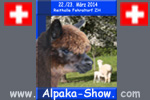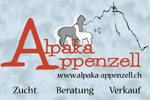Articles by Alpaca World Magazine:
A Visit to Wolstom
Jacqueline Wears
A visit to Wolstorm; the sustainable Alpaca Farm in the Netherlands
by Jacqueline Weers www.detekstelier.com
When Margriet Moed and Erica Krikken first set eyes on an alpaca, they were smitten. Starting out with a small group of animals grazing in the pasture behind Margriet?s house, they now own a large herd that supplies the wool for the first eco-friendly Alpaca-wool mill in the Netherlands.
Wide landscapes and endless horizons
On a bright April morning, I drive along a deserted country road in the direction of Westerlee, a tiny village in the northern tip of the Dutch province Groningen. Apart from the occasional farmhouse, there is nothing but endless meadows as far as the eye can see. An iron gate with the sign 'Wolstorm?, shows me that I?ve arrived at my destination. Stepping out of my car, I am immediately surrounded by three frantically enthusiastic dogs that trail behind me as I look for the entrance to the wool mill. The first door of the building to my left opens on to a narrow hallway, which gives access to a huge open space with all kinds of impressive machinery. A woman emerges from behind one of the machines. She shakes my hand warmly and introduces herself as Margriet, one of the two owners of Wolstorm.
We sit down for tea in a small showroom next to the mill, where strands of Alpaca wool in various natural colors are neatly stacked on wooden shelves. I also see socks, blankets and a collection of alpaca-wool lined muffs. I run my hands over the wool, amazed at its softness. A moment later Erica, the second half of the Wolstorm duo, enters the room. They don?t need much prompting to start a lively recount of the history of their enterprise. It quickly becomes evident that Wolstorm is much more than just a business for Erica and Margriet. These two women are driven by their undeniable passion for the alpaca.
One look and you?re hooked
It all started out as a hobby. After recovering from a serious illness, Margriet wanted to do something completely different with her life. A couple of animals in the backyard seemed like a good place to start, but what kind of animals? After considering horses and ostriches, Margriet saw a documentary about alpacas on television and became so curious about the animals that she decided to travel to Belgium and Switzerland to visit local alpaca farms. "Well, I learned the hard way that it?s dangerous to go and take a look," she explains. ?Because once you see them for real, you?re hooked.? Margriet went home in the company of her first three alpacas, who received a spot in the pasture beside the farmhouse. But her quest was far from over. Margriet wanted to know more about her new protégés and ended up visiting various alpaca farms in Russia and later even traveled to Chile. There, in the highlands of the Andes, Margriet bought her first herd of sixteen alpacas, which were transported by air to their new dwellings in the juicy meadows of the Dutch landscape.
Margriet also owes her encounter with business partner Erica to her alpacas. Erica's husband delivered the concrete for the new barn and told his wife about "Those cute little lamas in the pasture behind the Krikken farm." After she dropped by to see the animals for herself, she instantly fell in love with the gentle, long necked fluff balls. That was the birth of a joint enterprise between the two alpaca-loving ladies.
Let?s do something with the wool
Their Alpaca herd thrived, but Margriet and Erica felt they wanted to do something more than just breed and show off their alpacas during alpaca fairs. And it seemed like such a waste to discard all the wool left behind from the annual shearing rounds. In 2012, they got serious about the idea to ?do something with the wool?. Trips to the United States and Canada soon followed, where they witnessed the ins and outs of alpaca wool spinning. They had to travel overseas to get their information, as the entire wool spinning industry has disappeared from the Netherlands. During the sixties, all the wool industry moved to the low-income countries and there are currently no Dutch wool mills left. After visiting various wool mills throughout the USA and England, they finally found machines that were small enough to fit into Margriet?s barn. A huge investment and yet, they still had no idea how to use their brand new machinery. So they had an expert from Canada fly over, who taught them the ropes of alpaca wool spinning during a six-week crash course.
Animals first
For the Wolstorm duo, it?s paramount that their animals have a high quality of life, so they chose to follow the natural rhythm of the animals as closely as possible. Margriet: "Our herd is kept in a huge barn, which has an open connection to the outdoors area. The animals can venture outside whenever they choose. During the mating season, we allow one stallion at a time to join the females. If they feel like mating, that?s great and if nothing happens, that?s also fine with us. We leave it up to them. Outside of the mating season, the colts live in a separate pasture next to the herd, well protected by Quincy, our Lama.
"Soon, the cria will be born which is always an exciting moment.? Erica adds. "We let the cria wean naturally. After about six months, the mother produces less and less milk and at a certain point, the cria will stop asking for it. It?s much better for the animals that way. "
The floor of the barn is cleared out only twice a year. The manure is left to dry on the floor and covered with a new layer of straw on a regular basis. Two times a year, the thick plaque is scraped off the floor, after which the entire procedure is repeated. Margriet: ?The layer of manure and straw produces an excellent insulation for the young alpacas. And It?s much more eco-friendly, as we only have to clean the floor every six months.?
Wolstorm selects some of their registered alpacas as breeding stock to other alpaca owners, usually breeders who want to add a new bloodline to their herd or novice breeders.
The males that are not suitable for breeding are usually castrated. The castrated males were available for petting zoos and hobby farmers and sent to their new owners in groups of at least three, true to their herd nature. Currently Margriet and Erica no longer give their castrated males to third parties, as they have decided to hold on to all the animals for their wool.
From fleece to the finest yarn
They carefully shear their herd, which takes them about 45 minutes per animal. After the shearing process, the fleece is skirted by hand, washed in a tumbler and then entered into a picker machine, which blows the fleece to a fluffy mass. After the picking process, the wool is carded and combed on a draw-frame that pulls all the fibres into the same direction. The carded wool is then transferred onto a huge, multi coiled spinning machine and ultimately twined into cones.
Erica explains: "Until recently, we only had the natural tones off-white, gray and brown. We wanted to add more colors to our palette, but it had to be an eco-friendly, non-chemical dye. After a long search, we have found a beautiful natural wool paint in various colors that we are currently experimenting with. At the moment we sell mostly comforters and pillows, but in the near future we are planning to expand our product range. You could think of sweaters, jackets and wool blankets. "
Margriet: "We are convinced that there is a growing market for honest, eco-friendly and local products. People realize that you do not have to import your products from halfway around the world and there is an increasing environmental awareness. If you buy your products locally, at least you can be assured that no poison chemicals were used or that they were made with child labour. "
A fluffy lot
I'm quite eager to finally see the alpacas and I can?t help but ask: ?Could we ? please visit the alpacas now?? Margriet and Erica break out in laughter; it?s obviously not the first time a visitor makes this request. We walk to the back of the barn, enter through a gate and there they are; a huge flock of white, brown and greyish creatures, incredibly endearing to an alpaca novice like myself. They cautiously approach us, occasionally emitting a sound that makes my heart melt. A moment later, I?m surrounded by brown eyes and soft nuzzles. "My first encounter was exactly the same," laughs Erica. "Love at first sight!?
Behind us, a small herd of males hide behind a large llama that parades back and forth, eyeing me disapprovingly. Erica introduces him as Quincy, the official guardian of their boys. ?At first he did not like me at all, but now we are good friends. But do not come near his alpacas. He protects them fiercely. A llama can become quite aggressive, so no one will dare to come near them.?
I decide to make an effort to get acquainted with Quincy. At first he sniffles my bag, then starts pulling at the leather strings attached to it. I pat him on the head gently, while he explores my coat and hair. Then he places his huge head on my shoulder. "You passed the test!" says Erica.
As the highlight of the day, I am allowed to witness how the alpacas are released into the huge pasture, which lies right next to the barn. As soon as Margriet opens the fence, the entire herd bolts for the grassy plains in a long procession, descending upon the juicy grass and countless dandelions.
Big plans for the future
The word about the Dutch wool mill has already spread and Wolstorm is receiving requests for information from all over the world. ?People calling at all hours of the day asking us if we can spin their wool for them or give them courses?, says Margriet. But we?re careful. We only want to handle organically produced wool. If you have a great batch of natural wool, but it has subsequently been processed with chemicals in China, can you still assume that you have an organic product? We want to keep control over these things.? Currently, Wolstorm sells a lot of wool to local artists and several designers.
Erica adds: "We want to start out with daily guided tours of the farm, the wool mill and our farm shop and ultimately also focus on the overseas market. We are still in the process of establishing our business plans and many things have yet to take shape. But the beginning is already there. Erica shows me a separate space next to the spinning machine, where an information room with rows of seats and a beamer is in the making.
It is time to say goodbye. To the alpacas and to Margriet and Erica, who run their business with so much dedication and love for their animals. As I drive through the gate, I pass the herd, which is nibbling peacefully on the fresh spring grass, while the sun shines on their wooly backs. What a great alpaca life!
Text;
Wolstorm is an eco-friendly wool mill in the Netherlands.
Contact details;
Hoofdweg 33
9678 PE Westerlee/the Netherlands
00-31-(0)6-50122091
email; info@wolstorm.com
Tweet



